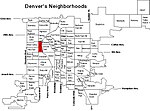Buckhorn Exchange
Buildings and structures completed in 1886Buildings and structures in DenverColorado Registered Historic Place stubsNational Register of Historic Places in DenverRestaurants established in 1893 ... and 4 more
Restaurants in ColoradoRestaurants in DenverRestaurants on the National Register of Historic PlacesSteakhouses in the United States

The Buckhorn Exchange is a historic landmark restaurant and American frontier museum located in Lincoln Park, Denver, Colorado. The restaurant opened in 1893 and is the oldest continuously operating restaurant in Denver.It was listed on the National Register of Historic Places in 1983 as the Zeitz Buckhorn Exchange.
Excerpt from the Wikipedia article Buckhorn Exchange (License: CC BY-SA 3.0, Authors, Images).Buckhorn Exchange
Zuni Street, Denver
Geographical coordinates (GPS) Address Nearby Places Show on map
Geographical coordinates (GPS)
| Latitude | Longitude |
|---|---|
| N 39.732222222222 ° | E -105.01611111111 ° |
Address
Zuni Street 953
80204 Denver
Colorado, United States
Open on Google Maps









